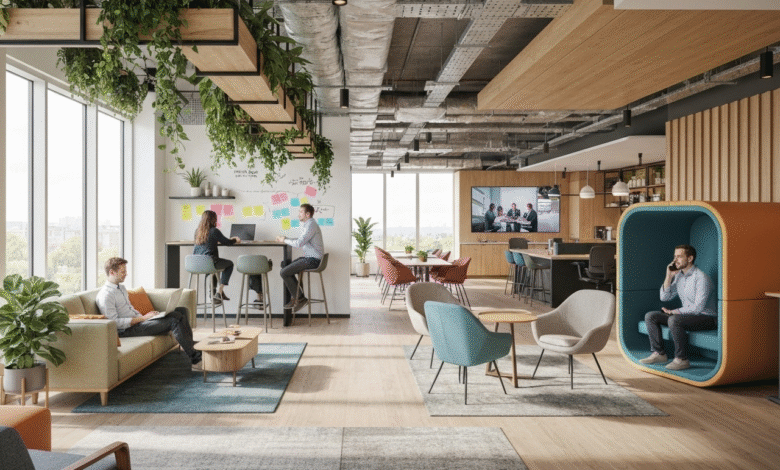Why Modern Offices Are Embracing Lifestyle Spaces

▼ Summary
– Modern offices are evolving from traditional sterile environments into lifestyle spaces that prioritize employee wellbeing, creativity, and community over mere functionality.
– Lifestyle offices draw inspiration from residential living, featuring flexible layouts with hospitality elements like lounges and breakout zones that adapt to different work modes.
– These workspaces enhance wellbeing through health-conscious design elements such as ergonomic furniture, good lighting, and layouts that encourage movement and reduce burnout.
– They foster collaboration and innovation by providing purpose-built zones for both individual focus and team interaction, supported by technology for seamless hybrid work.
– Investing in lifestyle office design strengthens company culture, helps attract and retain talent, and creates adaptable spaces that remain relevant as work patterns evolve.
Today’s office environment is undergoing a profound transformation, moving beyond traditional cubicles and fluorescent lighting toward spaces that genuinely support employee wellbeing and creativity. The modern office is no longer just a place to work; it has evolved into a lifestyle hub where professionals can connect, recharge, and perform at their best. This shift responds to a growing demand for workplaces that offer more than basic functionality, they must foster community, balance, and inspiration.
The journey of office design reflects broader changes in how we approach work. Flexibility has become the central theme, with layouts designed to adapt to various tasks and working styles. Far from becoming obsolete, the physical office now serves a renewed purpose: providing the energy, collaboration, and creative flow that remote work often lacks. Everything from furniture selection to lighting design plays a role in shaping this experience.
So what exactly defines a lifestyle office space? It draws inspiration from how people live outside of work, prioritizing comfort and choice. You’ll find hospitality-inspired elements like café-style lounges, casual breakout areas, and cozy nooks that encourage both focus and relaxation. Employees can seamlessly transition between solo tasks, group projects, and moments of rest, with the environment adjusting to meet their changing needs. This adaptability helps sustain engagement, reduce burnout, and transform the office into a destination people look forward to visiting.
Key features driving this new approach include biophilic design, coworking layouts, and wellness amenities. Practical touches like sit-stand desks, acoustic pods for private calls, wireless charging stations, and on-site fitness areas demonstrate a commitment to employee health and convenience. These elements aren’t mere luxuries, they’re essential components of a workspace designed for modern professionals.
The advantages of lifestyle office design extend across several critical areas:
Improving Wellbeing and Work-Life Integration Health-conscious office design has been shown to boost productivity, lower absenteeism, and support long-term mental wellness. Strategic use of natural light supports circadian rhythms, while ergonomic furnishings minimize physical strain. Layouts that encourage movement and provide quiet retreats help employees feel more in control of their day. These features make the difference between enduring the workday and thriving within it.
Sparking Creativity and Teamwork Gone are the days when open-plan layouts were the only option for collaboration. Lifestyle offices incorporate purpose-built zones tailored to different activities, from focused individual work to dynamic group sessions. Communal worktables, writable walls, soundproof collaboration booths, and hybrid-ready meeting areas facilitate spontaneous brainstorming and problem-solving. When teams can easily gather around a whiteboard or exchange ideas in a lounge setting, innovation happens more naturally.
Reinforcing Organizational Culture Physical space powerfully communicates company values and identity. A lifestyle office makes brand attributes tangible, whether through sustainable materials, inclusive design, or curated artwork. The moment someone steps inside, they gain insight into what the organization stands for. Employees notice these details, often feeling a stronger sense of pride and alignment with a company that visibly invests in their daily experience.
Winning the War for Talent With remote work here to stay, the physical workplace must offer compelling reasons for employees to come in. Lifestyle offices provide an experience that virtual settings can’t match, infused with community, convenience, and vitality. By investing in quality flexible furniture, social areas, and advanced technology, companies signal that they value flexibility, wellbeing, and forward-thinking practices. This not only helps attract top talent but also boosts retention by creating an environment where people genuinely want to spend their time.
Technology serves as a vital enabler in these spaces. Reliable Wi-Fi, cloud-based tools, and connected devices allow smooth transitions between focused work and collaboration. High-quality video conferencing systems make remote participants feel present during workshops or client presentations. Beyond meetings, occupancy sensors and reservation apps provide data to optimize space usage and ensure resources are available when needed.
Designing for the future means creating offices that can evolve. Modular walls, movable furniture, and multi-purpose zones allow spaces to adjust to changing team sizes and work patterns without costly renovations. Sustainability is another crucial consideration, with energy-efficient systems, responsibly sourced materials, and circular economy models reducing environmental impact while cutting long-term costs. Offices that gather feedback and analyze usage data can continually refine their layouts to meet emerging needs.
Ultimately, a lifestyle office represents an ongoing commitment to the people who use it every day. It blends thoughtful design, quality furnishings, and smart technology to create environments that support both individual and collective success. By prioritizing flexibility, comfort, and functionality, these spaces not only enhance daily work life but also position organizations to adapt smoothly to future changes in team structures, technologies, and employee expectations.
(Source: ITWire Australia)
